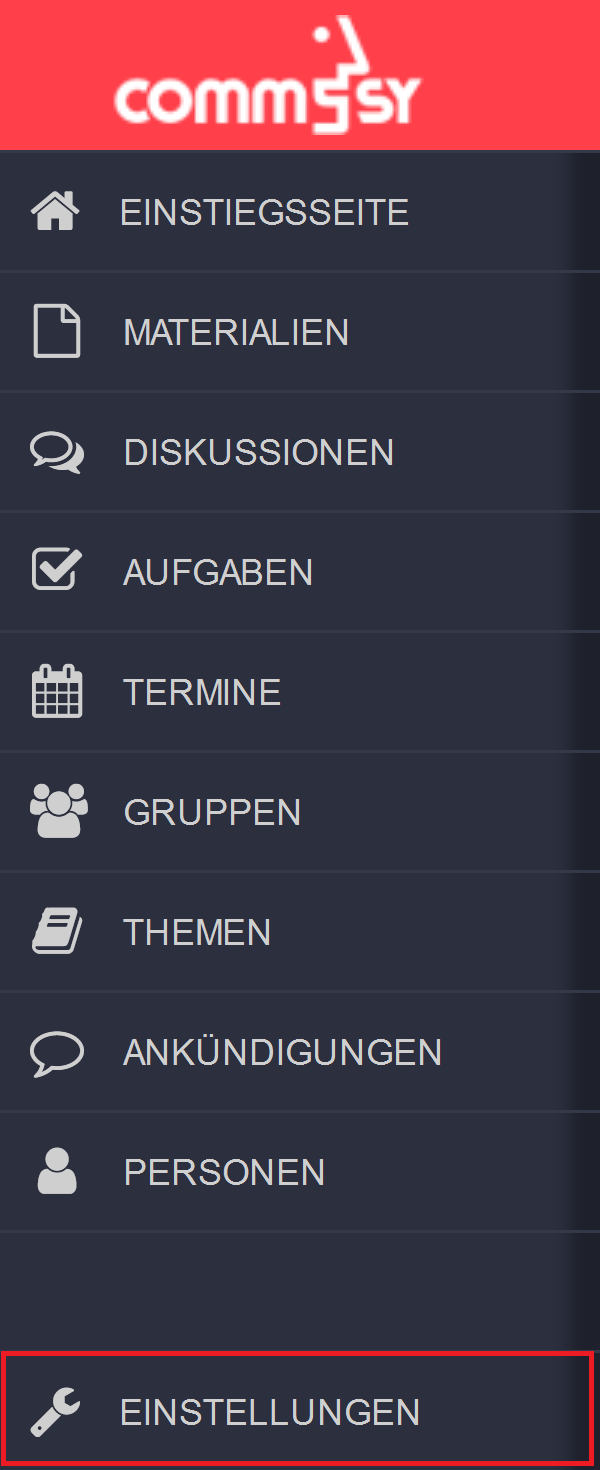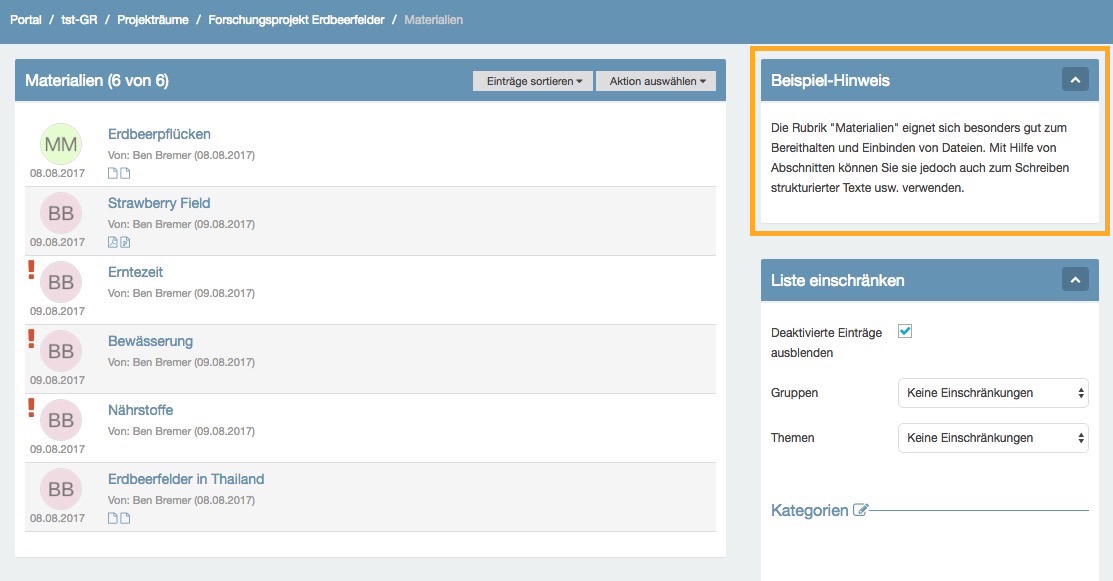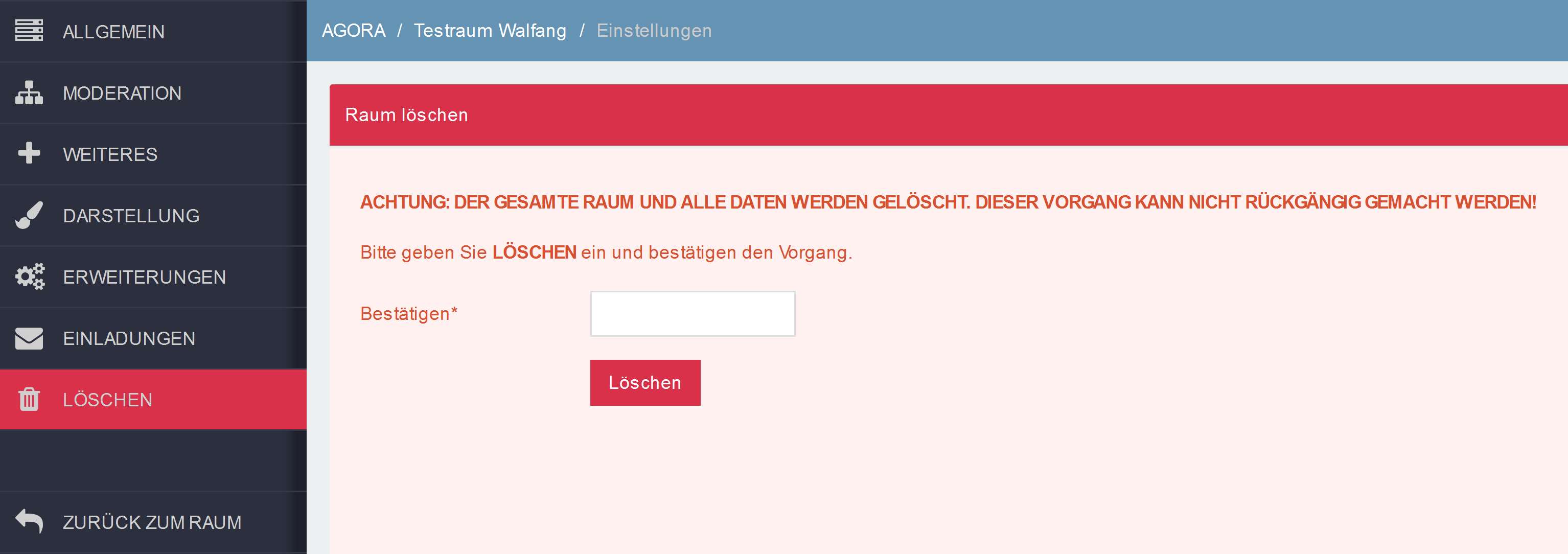Room Settings
In this tutorial, you will find an overview of the seven menus hidden under "Settings" at the bottom of your room's sidebar. With these, you can individually configure the functionality of your room.

To configure a project room, you must have created the room yourself or be a moderator of this project room. A moderator has various options in CommSy to adapt a project room to their or the group's needs using the settings options. You can find the "Settings" button with the wrench icon in the sidebar (highlighted in Fig. 1).
| Note: The "Settings" area is only accessible to moderators of a room; other participants do not see this button. |
1. General
In the first menu, "General," you can adjust important settings after creating the room. It is important to always click "Save" at the bottom after you have made any changes to the room settings.
In the first section of this menu, "Basic Settings," you can change the title and language of the room, adjust the assignment to community rooms, and add a room description. You will also find the participation and category settings explained below.
Participation Review: Here, you can decide whether to never review, always review, or review participation requests using a code.
- "Always": With the "Always" setting (default), you will receive emails containing a link that leads to approving the requester.
- "Code": This option is particularly advantageous for events with many participants. If you select this option, you must enter a code in the text field. You can announce this code at the beginning of a face-to-face event, allowing participants to register themselves in the room.
- "Never": With the "Never" setting, requesters gain direct access to the room without participation review. We only recommend this setting in exceptional cases.
| Tip: Especially for large events, it can be beneficial for you to set a participation code so that you don’t have to approve each requester individually. |
Category Selection: You will also find the category settings in this menu. Here, you can change the order of the categories by dragging and dropping them to rearrange. You will find a dropdown menu next to each category.
- Option "Show": This category will appear in the sidebar and on the homepage.
- Option "Hide": Entries in this category will not show on the homepage.
- Option "Disabled": This category will not be available in the CommSy room.
The participants' category will always be displayed to you if you are a moderator of a room. In all other cases, as a moderator, you will see the same view as all other participants of the room.
| Tip: For example, you can "Hide" the participants' category to prevent all new participants from appearing in the feed on the homepage. |
Room Labeling: You can automatically add participants from STiNE to your CommSy room. However, this only works if the respective persons have logged into CommSy at least once before. So don’t be surprised if the list of participants in your CommSy room fills up only gradually, especially during first-semester events.
To navigate to your course in STiNE, first, copy the STiNE course ID (a numeric identifier of the course in STiNE). You will find this in the top right corner next to the course details; it usually starts with a 3 followed by 12 digits:

Then, open your CommSy room. Click on "Room Settings," then on "General," and scroll down to the section "Room Labeling." Here, insert the STiNE ID:

If the STiNE course ID has already been used by someone else for a CommSy room, the same STiNE course ID cannot be used for another CommSy room. If your STiNE ID is no longer available, please send an email to support.
|
Tip: Check out the video tutorial on linking STiNE to CommSy! You may also find our FAQs on "Room Labeling" helpful: |
2. Moderation
Under the second menu item, "Moderation," you can make various individual changes to the room. For instance, you can display a notice on the overview page of your room, adjust usage guidelines for the individual categories, or edit default email texts that are sent about the room, such as when new users are approved.
Notice Text on the Homepage: You can place material, a task, a date, or an announcement as prominent notice text in the banner on the homepage by providing the reference number of the desired entry here. You can find the reference number below the title of an entry by clicking on the arrow icon (next to "Edit").
Usage Guidelines: You can display usage guidelines in various categories that will be shown in the right column. Choose a category and then enter your text, such as instructions on which contents should be posted in this category. If you save the settings now (at the very bottom), the personalized notice text will appear in the right column of the respective category.

Email Configuration: The email texts that are sent out about the room (e.g., when approving new participants) can be adjusted here. You can select the "component" of the standard texts you want to change via the dropdown menu, such as the greeting or salutation. The % signs and numbers in these texts are placeholders that you should not remove, as the name, etc., will be automatically inserted at these points later.
3. Miscellaneous
In the "Miscellaneous" menu, you will find several options that further optimize your room or enable interesting functions.
Structuring Aids: Here, you can set whether and how the structuring aids "Keywords" and "Categories" should be displayed in the categories of your room. More detailed information about the structuring aids can be found in the tutorial "Structuring Room Contents." You can also determine to what extent room participants can edit the calendar.
Tasks: Here, you can define whether additional statuses should be set beside the three processing statuses "not processed," "in process," and "completed" for the Tasks category, and add them if necessary.
RSS Feed: If you enable this option, participants can subscribe to the activities in this room via RSS. By default, this option is turned off.
Template: You can make your room available as a template, which is particularly worthwhile for you as an instructor if you repeatedly run seminars with almost unchanged materials. You don’t need to re-upload these materials for each seminar; instead, you can make the old room available as a template here and select the template when creating a new room. Under "Target Group," you can also specify for whom the template should be usable in the future: for all CommSy users, all members of this room, or only for you and possibly other room moderators. If you enter a description, such as with information about the contents, it will be displayed later when selecting the template. You can find more details and useful tips on this topic in the tutorial "Reusing Content."
Archiving Room: If you archive a room, it will remain accessible with all its contents but will no longer be editable, meaning no new content can be added. For instance, if a seminar for which you created the project room belongs to a past semester, and you do not expect (or desire) any further changes to the contents, you can archive the room here.
Terms of Use: You can set individual terms of use for your room that participants must accept before they can use the room. Set the status to "Yes" and enter text if you want to use this feature.
4. Appearance
In this menu, there are various settings related to the appearance and design of the room.
Calendar View: You can select different default views for the "Calendar" category. The list view shows the calendar as a chronologically ordered list of entries. This selection is very clear if you have only a few appointments that are spread over several months. The monthly and weekly views display the traditional calendar sheet view.
Color Configuration: Select a color scheme for the room here. This is linked to the theme image (see below), which you can change. Each color scheme is associated with different accent colors, which are used for bars in the room, for example.
Room Image: The standard preset image of the current theme is always used. However, you can also upload your own image for the homepage of the room. For optimal display, the image should have an aspect ratio of about 5:1 and be at least 1300 pixels wide.
Room Logo: Here, you can add a logo for your room, which will be displayed on the homepage above the room image. Images with a transparent background are particularly suitable as room logos.
5. Extensions
In this menu, you will find the settings for three useful extensions for your room, briefly explained below.
Personal Rooms: The new CommSy function "Personal Room" creates a dedicated area accessible only to room moderators and an individual student. The room moderators can assign individual tasks here and then correct them after completion—visible only to the respective students. A project room's moderator can enter every personal room of the project room; students, however, can only enter their own personal room.
Ratings: Enable entry ratings, allowing participants in the room to rate entries (e.g., discussion contributions) with stars. Thus, entries can be rated with up to five possible stars, which can signify their quality.
| Tip: This feature can be useful if you are a seminar leader and your participants are to regularly write small discussion contributions on a particular topic. The star rating can serve as valuable feedback for the authors of the contributions. |
Workflow Settings: Workflow support refers to an additional setting for the "Materials" category. They can be found both in the list of all entries in the category and at the top right of each material entry. To change the status of a material entry, open the entry and edit the "Workflow" section. Here, you can select the status and save it.
Furthermore, if activated in the settings, a date for a reminder can be set, and a message can be sent to the creator, all editors, or individual email addresses if this date is exceeded. The same can be set for assigning a validity date.
Finally, there is the "Read Receipt" setting, which you can activate for the room and which will also be displayed in the "Workflow" section of the material entry. Room participants can then indicate for each individual entry that they have read it (e.g., as homework). First, select "Personalized" if you want to use this setting unless you explicitly want to know the reading status from participant groups. Select "Read Receipt only for moderators," otherwise all room participants can see who has read which contribution.

6. Invitations
In general, all members of UHH can log in independently with their user credentials. Therefore, they do not need to be invited this way. However, if you want to invite a non-member of UHH to one of your rooms, as a moderator, you can send an invitation to people without access to the platform in this menu of room settings. Enter the email address of the person you wish to invite; then click "Send Invitation." The person will receive a one-time-use activation code and instructions for signing up for the portal. After successfully creating an account on the platform, they can now apply to participate in the desired room.
You can also delete an invitation if it has not yet been redeemed.

7. Deletion
The button to lock and delete your room is found last in the settings menu and is highlighted in red.
- Lock Room: You can lock your project room, preventing anyone from accessing it. However, your contributions will remain.
- Delete Room: Please note that the deletion process cannot be undone, and all data in the room will be irretrievably lost. If you truly want to delete your room, type the word "DELETE" into the text field and click the "Delete" button to confirm the deletion process definitively.

